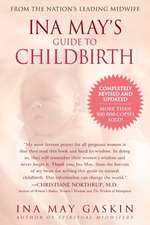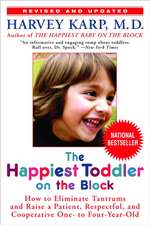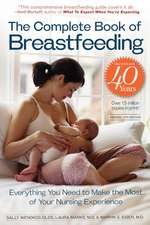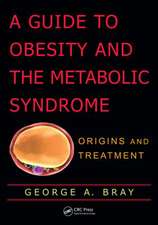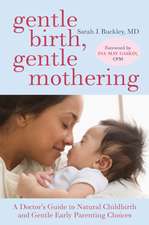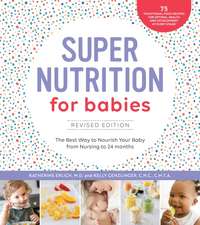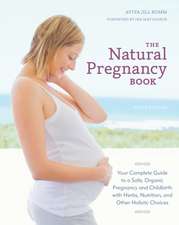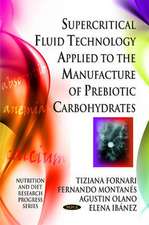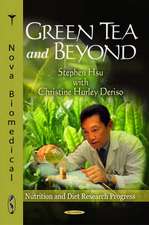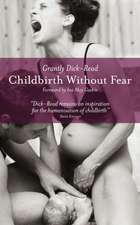Ina May's Guide to Breastfeeding
Autor Ina May Gaskinen Limba Engleză Paperback – 31 aug 2009
Drawing on her decades of experience in caring for pregnant women, mothers, and babies, Ina May Gaskin explores the health and psychological benefits of breastfeeding and gives you invaluable practical advice that will help you nurse your baby in the most fulfilling way possible. Inside you’ll find answers to virtually every question you have on breastfeeding, including topics such as
•the benefits of breastfeeding
•nursing challenges
•pumps and other nursing products
•sleeping arrangements
•nursing and work
•medications
•nursing multiples
•weaning
•sick babies
•nipplephobia, and much more
Ina May's Guide to Breastfeeding is filled with helpful advice, medical facts, and real-life stories that will help you understand how and why breastfeeding works and how you can use it to more deeply connect with your baby and your own body. Whether you’re planning to nurse for the first time or are looking for the latest, most up-to-date expert advice available, you couldn’t hope to find a better guide than Ina May.
| Toate formatele și edițiile | Preț | Express |
|---|---|---|
| Paperback (2) | 69.53 lei 3-5 săpt. | +21.78 lei 4-10 zile |
| Pinter & Martin Ltd – 5 oct 2009 | 69.53 lei 3-5 săpt. | +21.78 lei 4-10 zile |
| Bantam – 31 aug 2009 | 116.51 lei 3-5 săpt. |
Preț: 116.51 lei
Nou
Puncte Express: 175
Preț estimativ în valută:
22.30€ • 24.23$ • 18.75£
22.30€ • 24.23$ • 18.75£
Carte disponibilă
Livrare economică 31 martie-14 aprilie
Preluare comenzi: 021 569.72.76
Specificații
ISBN-13: 9780553384291
ISBN-10: 0553384295
Pagini: 352
Dimensiuni: 153 x 228 x 20 mm
Greutate: 0.48 kg
Editura: Bantam
ISBN-10: 0553384295
Pagini: 352
Dimensiuni: 153 x 228 x 20 mm
Greutate: 0.48 kg
Editura: Bantam
Notă biografică
Ina May Gaskin, certified professional midwife, has been a midwife for more than thirty years at The Farm Midwifery Center at The Farm, in Summertown, Tennessee.
Extras
Chapter One
How Breastfeeding Works,and How It Relates to Mothering
We women are all born with the right equipment for breastfeeding. Big breasts, tiny breasts, long nipples, flat nipples, light nipples, and dark nipples all work very well for milk-making and breastfeeding. The basic milk-producing equipment is present in all the variations that we see in the human female. Why, then, is it so much easier for some women to breastfeed than it is for others? This chapter is intended to give you a foundation for understanding why this is so. There are external factors that can interfere with your innate ability to nurse your baby, but the important thing for you to remember is that these have nothing to do with the body you are dealt at birth, which has the capacity to work right.
Breasts are amazing, complex organs, which are able to produce, secrete, and deliver the most perfect food possible to your baby, who is hardwired to take it in. Your breasts are even talented enough to adjust the composition of your milk according to the gestational age of your baby at birth and to the amount of heat and humidity in your environment at any given moment.
Let’s take a quick look now at the different kinds of tissues that make up your breasts. First there is the glandular tissue of your breasts, the network of grapelike clusters (alveoli) and ducts that make the milk and move it along. Next, your breasts contain a web of ligaments that help to support their weight. Then there are the nerves of the breast and nipple, which make them sensitive to touch. It is this network of nerves that responds to your baby’s nuzzling, suckling, head-bobbing, and caressing, by sending the message to your pituitary gland to secrete prolactin, the hormone that signals your breasts to make milk. You’ll probably learn later on that your baby’s cry and even the thought of your baby can do the same thing. The rest of your breast tissues are the more-liquid components: the blood, which nourishes all the rest of the tissues and provides the nutrients needed to make milk, and the lymph, which removes wastes.
By the way, none of the tissues mentioned so far has anything to do with the size of your breasts. Breast size depends upon the amount of fatty tissue in your breasts, not upon the amount of glandular (milk- making) tissue. Some of us have a lot of fat in our breasts, while others have more-moderate amounts or very little. The amount of fat has no effect on our ability to make milk. Pregnancy means dramatic breast growth in some women, but women who still have tiny breasts at the end of pregnancy are quite able to fully breastfeed their babies.
Your nipple sticks out from your areola; it is in the middle of the darker-colored part of your breast. Both nipple and areola contain erectile muscle tissue. When your nipple is stimulated by touch, cold, or a visual or auditory cue, these muscles contract, and your nipple becomes hard and erect. Once your baby takes it into her mouth properly, it will take on an entirely different shape, doubling in length and conforming to the shape of your baby’s mouth cavity.
Hormones That Affect Lactation and How to Elicit Them
It takes more than the right “equipment” to make milk—it is also necessary for that equipment to get the signal that it is time to start producing and releasing the milk. This is the job of certain hormones that are produced in the body, hormones that may rise or fall according to the mother’s stress level and the atmosphere in which she first starts suckling her baby.
Oxytocin
The hormone oxytocin plays as large a role in lactation and mothering as it does in the process of labor and birth. When you feel your uterus contract during or after labor, you are feeling just one of the many effects of oxytocin: in this case, the ability to expel something from a bodily organ. Oxytocin not only stimulates the muscles of the uterus to expel the baby at the culmination of labor, it also stimulates the muscles of the breast to expel milk during nursing in what is called the “letdown reflex.”
Oxytocin has been called the “hormone of calm, love, and healing” because of the kinds of feelings it causes in the mother and the interactions with her baby that often trigger its release.1 For instance, it has been found that a newborn baby can cause additional oxytocin release in the mother’s bloodstream by massaging, nuzzling, or licking her nipple. Both skin-to-skin contact and eye-to-eye communication between mother and baby also trigger the release of oxytocin. Under the influence of high oxytocin levels, mother and baby tend to stare at each other lovingly, provided that skin-to-skin contact—or only light clothing between them—is the norm just after birth and there are no distractions or interruptions.
Extremely high levels of oxytocin persist in the bloodstreams of mother and baby for about an hour after vaginal birth, giving both a feeling of well-being and gratitude. Higher levels than usual will persist throughout the nursing period, as long as the mother doesn’t have extremely high levels of stress (since high levels of stress hormones inhibit the secretion of oxytocin).
And though severe stress can sometimes inhibit the release of oxytocin, research has also shown that oxytocin often lowers stress in lactating women by slowing the heart rate and reducing blood pressure. There is evidence that the powerful calming effect that breastfeeding can have on a mother during the early weeks of life is long-lasting: Dr. Kerstin Uvnäs Moberg, a Swedish oxytocin researcher, found that women who breastfed their babies for the first seven weeks were calmer when their babies were six months old than women who never breastfed. Her research team also found that small amounts of oxytocin reduce anxiety and increase curiosity and a willingness to relate with another being. In Moberg’s words, “Oxytocin is physiology’s ‘forget-me- not’ that makes recognition and bonding reverberate in the nerves’ pathways.” Larger amounts of oxytocin, such as that which a mother and baby might experience during a longer nursing session, produce a more pronounced calming effect—a tendency to move around less, to relax and rest. The same research team discovered that oxytocin also alleviates pain. When a rat is given repeated oxytocin injections, it will take longer than usual to pull its tail out of water that is too hot. Oxytocin’s ability to reduce pain applies to both mother and baby and is a blessing that is quite noticeable when a breastfed baby must undergo a painful medical test or a new mother is healing after a cesarean.2
Are you surprised that one hormone can do so many different things related to nurturing and parenting? Actually, it can do all that and more. To illustrate what I mean, it is worth knowing that we women have the ability to produce oxytocin even when we aren’t pregnant. (Men can produce it too, but its effects are more pronounced in females.) Oxytocin levels in the body rise when we enjoy a good meal (when we take the time to focus on it), whether alone or in the company of people we enjoy. It is no accident that business people consummate so many deals around a shared meal, as eating together causes oxytocin levels to rise, thus instilling a sense of calm and trust that makes it easier for people to cooperate with one another.
Another stimulus to oxytocin release in both sexes is pleasant, rhythmic touch. Much research has confirmed that oxytocin levels rise when we receive a hug from someone we care for or a soothing massage, as well as during meditation, a warm bath, or sexual arousal. As oxytocin levels rise, blood pressure drops, heart rate slows, and the digestive system functions at maximum efficiency. The same goes for healing: Our bodies heal better when oxytocin levels are high and our stress hormones are at a low ebb. When we are under the influence of oxytocin, problems that may have been bothering us previously tend to move into the background, and we may view our situation in a more positive way. We may also feel an enhanced sense of closeness to others and an impulse to greater generosity.
Consider the experience of Jiang Xiaojuan, the twenty-nine-year-old Chinese policewoman who was called a national hero by the media after the Jiangyou earthquake of May 2008. Officer Xiaojuan nursed nine babies whose mothers were injured or killed in the earthquake. For Officer Xiaojuan, whose own son was six months old, it was a simple matter. “I am breastfeeding,” she said, “so I can feed babies. I didn’t think of it much. It is a mother’s reaction and a basic duty as a police officer to help.”
While she was bemused about the media fuss over her actions, she did allow that she felt something special for these little ones: “I feel about these kids I fed just like my own. I have a special feeling for them. They are babies in a disaster.” I’m sure that this policewoman’s actions were prompted not only by a sense of duty but also by the increased level of oxytocin that she experienced when she encountered the hungry babies. Her milk flowed in greater quantities than usual because she felt a need to feed these helpless little ones.
All mammals share the ability to produce oxytocin, and expressions of maternal kindness and generosity are not limited to our own species. The Sriracha Zoo near Bangkok, Thailand, has attracted a lot of media attention in recent years for its cross-species suckling arrangements. Zookeepers there apparently do a certain amount of intentional “baby- snatching,” which is then followed by successful foster relationships that zoo visitors find entertaining. From this, we get the improbable sight of a sow suckling tiger cubs or of a six-year-old royal bengal tigress (who was suckled by a pig for her first four months of life) suckling six piglets and behaving as any loving, protective mother would toward her charges. Clearly, the zookeepers rely on the power of oxytocin to pull off such stunts.
Who wouldn’t want to have high oxytocin levels during pregnancy and birth? This is best accomplished by having as much contact with your baby as possible right after birth. As mentioned, skin-to-skin contact is best, but even with clothes on and your baby wrapped in a receiving blanket, your oxytocin levels can be enhanced by just holding and caressing her. If you have had a stressful birth, holding and cuddling your baby will usually improve the way you feel almost instantly. One of the few exceptions to this would be if you feel so weak following birth that you are on the point of fainting. Common sense, of course, should rule in these matters. The amount of contact you have with your baby just after birth may vary according to whether you gave birth vaginally and whether your perineum needs stitching. However, women who have cesareans or need perineal repair will also benefit by both seeing and touching their babies as much as possible in the moments soon after birth.
More generally, the way to have a high level of oxytocin after birth is to avoid stress. Here I’m not referring to the work or even the pain of birth. Rather, this means any factor—including the people assisting your birth—that interferes with your ability to connect with your baby once her breathing is spontaneous and unassisted. This is especially important during your child’s first hour of life—a period of extraordinary sensitivity for both you and your baby, when your respective systems are meant to be in attunement.
Beta-endorphin
Beta-endorphin is another hormone that has an important function around the time of birth and breastfeeding. From ancient times, humans have known about opiates (drugs derived from the opium poppy) and their ability to kill pain and produce ecstatic states of consciousness. However, it wasn’t until the mid-1970s that researchers discovered that the human body produces its own opiate: beta- endorphin. It is secreted by the pituitary gland and the hypothalamus in circumstances of stress, muscular effort, excitement, orgasm, and pain. Its properties are similar to those of morphine, heroin, and meperidine (Demerol), a painkiller commonly used in maternity wards in the United States, and it works on the same receptors of the brain. Anyone who follows sports closely is aware of the phenomenon that occurs when an athlete is injured on the playing field but is able to continue playing without feeling much pain. High levels of beta- endorphin are very effective at blocking pain receptors.
Beta-endorphin has another function: It facilitates the release of the hormone prolactin during labor, which prepares the mother’s body for lactation and helps the baby’s lungs finish their maturation process. Beta-endorphin is present in high levels for about three days following birth and then returns to its former level. However, it remains present in breast milk, which helps to account for the blissful expression we see on the faces of babies who have just enjoyed a good session at the breast.
Prolactin
Now we come to prolactin, which has been called the “mothering” or “nesting” hormone. Pro lactin, incidentally, means for milk in Latin. It is released by the pituitary gland during pregnancy and lactation and prepares the pregnant woman’s breasts for lactation by causing the maturation and proliferation of the mammary ducts and alveoli. High levels of the hormone progesterone inhibit the production of milk during pregnancy (though, in many women, not to the point of suppressing lactation if they are still nursing an older child). Progesterone and estrogen levels drop abruptly after birth, and prolactin causes the milk-producing cells in the mother’s breasts to begin producing first colostrum and then milk.
Prolactin is related to other forms of mothering behavior as well. It has to do with nest building, grooming, and comforting. Michel Odent has written that while oxytocin creates a need to love, prolactin creates a tendency “to direct the effects of the love hormone toward babies.”3 Prolactin is likely to be the hormone that urges the mother to put her baby’s needs first and foremost.
Other effects of prolactin include stimulating the secretion of oxytocin and natural painkillers such as beta-endorphin, and the suppression of fertility. Like oxytocin, prolactin also helps reduce stress—for both mother and baby.
Interestingly, men and women have similar prolactin levels when there is no pregnancy.4 Studies have shown that fathers-to-be have increased prolactin levels, paralleling the increased levels of their partners. Holding babies appears to raise prolactin levels in men as well as women, and new fathers’ prolactin levels also increase when they hear their babies’ cries.5–6 New fathers with high prolactin levels tend to be more responsive to their newborns’ cries.
To sum up this discussion about the hormones that facilitate lactation, ease of breastfeeding is directly related to having high levels of oxytocin, beta-endorphin, and prolactin in the bloodstream around the time of birth. Nature endows each woman with the equipment to produce these hormones, but in stressful environments it can become more difficult for her to secrete them in the necessary amounts. This will be discussed later on in the chapter.
How Breastfeeding Works,and How It Relates to Mothering
We women are all born with the right equipment for breastfeeding. Big breasts, tiny breasts, long nipples, flat nipples, light nipples, and dark nipples all work very well for milk-making and breastfeeding. The basic milk-producing equipment is present in all the variations that we see in the human female. Why, then, is it so much easier for some women to breastfeed than it is for others? This chapter is intended to give you a foundation for understanding why this is so. There are external factors that can interfere with your innate ability to nurse your baby, but the important thing for you to remember is that these have nothing to do with the body you are dealt at birth, which has the capacity to work right.
Breasts are amazing, complex organs, which are able to produce, secrete, and deliver the most perfect food possible to your baby, who is hardwired to take it in. Your breasts are even talented enough to adjust the composition of your milk according to the gestational age of your baby at birth and to the amount of heat and humidity in your environment at any given moment.
Let’s take a quick look now at the different kinds of tissues that make up your breasts. First there is the glandular tissue of your breasts, the network of grapelike clusters (alveoli) and ducts that make the milk and move it along. Next, your breasts contain a web of ligaments that help to support their weight. Then there are the nerves of the breast and nipple, which make them sensitive to touch. It is this network of nerves that responds to your baby’s nuzzling, suckling, head-bobbing, and caressing, by sending the message to your pituitary gland to secrete prolactin, the hormone that signals your breasts to make milk. You’ll probably learn later on that your baby’s cry and even the thought of your baby can do the same thing. The rest of your breast tissues are the more-liquid components: the blood, which nourishes all the rest of the tissues and provides the nutrients needed to make milk, and the lymph, which removes wastes.
By the way, none of the tissues mentioned so far has anything to do with the size of your breasts. Breast size depends upon the amount of fatty tissue in your breasts, not upon the amount of glandular (milk- making) tissue. Some of us have a lot of fat in our breasts, while others have more-moderate amounts or very little. The amount of fat has no effect on our ability to make milk. Pregnancy means dramatic breast growth in some women, but women who still have tiny breasts at the end of pregnancy are quite able to fully breastfeed their babies.
Your nipple sticks out from your areola; it is in the middle of the darker-colored part of your breast. Both nipple and areola contain erectile muscle tissue. When your nipple is stimulated by touch, cold, or a visual or auditory cue, these muscles contract, and your nipple becomes hard and erect. Once your baby takes it into her mouth properly, it will take on an entirely different shape, doubling in length and conforming to the shape of your baby’s mouth cavity.
Hormones That Affect Lactation and How to Elicit Them
It takes more than the right “equipment” to make milk—it is also necessary for that equipment to get the signal that it is time to start producing and releasing the milk. This is the job of certain hormones that are produced in the body, hormones that may rise or fall according to the mother’s stress level and the atmosphere in which she first starts suckling her baby.
Oxytocin
The hormone oxytocin plays as large a role in lactation and mothering as it does in the process of labor and birth. When you feel your uterus contract during or after labor, you are feeling just one of the many effects of oxytocin: in this case, the ability to expel something from a bodily organ. Oxytocin not only stimulates the muscles of the uterus to expel the baby at the culmination of labor, it also stimulates the muscles of the breast to expel milk during nursing in what is called the “letdown reflex.”
Oxytocin has been called the “hormone of calm, love, and healing” because of the kinds of feelings it causes in the mother and the interactions with her baby that often trigger its release.1 For instance, it has been found that a newborn baby can cause additional oxytocin release in the mother’s bloodstream by massaging, nuzzling, or licking her nipple. Both skin-to-skin contact and eye-to-eye communication between mother and baby also trigger the release of oxytocin. Under the influence of high oxytocin levels, mother and baby tend to stare at each other lovingly, provided that skin-to-skin contact—or only light clothing between them—is the norm just after birth and there are no distractions or interruptions.
Extremely high levels of oxytocin persist in the bloodstreams of mother and baby for about an hour after vaginal birth, giving both a feeling of well-being and gratitude. Higher levels than usual will persist throughout the nursing period, as long as the mother doesn’t have extremely high levels of stress (since high levels of stress hormones inhibit the secretion of oxytocin).
And though severe stress can sometimes inhibit the release of oxytocin, research has also shown that oxytocin often lowers stress in lactating women by slowing the heart rate and reducing blood pressure. There is evidence that the powerful calming effect that breastfeeding can have on a mother during the early weeks of life is long-lasting: Dr. Kerstin Uvnäs Moberg, a Swedish oxytocin researcher, found that women who breastfed their babies for the first seven weeks were calmer when their babies were six months old than women who never breastfed. Her research team also found that small amounts of oxytocin reduce anxiety and increase curiosity and a willingness to relate with another being. In Moberg’s words, “Oxytocin is physiology’s ‘forget-me- not’ that makes recognition and bonding reverberate in the nerves’ pathways.” Larger amounts of oxytocin, such as that which a mother and baby might experience during a longer nursing session, produce a more pronounced calming effect—a tendency to move around less, to relax and rest. The same research team discovered that oxytocin also alleviates pain. When a rat is given repeated oxytocin injections, it will take longer than usual to pull its tail out of water that is too hot. Oxytocin’s ability to reduce pain applies to both mother and baby and is a blessing that is quite noticeable when a breastfed baby must undergo a painful medical test or a new mother is healing after a cesarean.2
Are you surprised that one hormone can do so many different things related to nurturing and parenting? Actually, it can do all that and more. To illustrate what I mean, it is worth knowing that we women have the ability to produce oxytocin even when we aren’t pregnant. (Men can produce it too, but its effects are more pronounced in females.) Oxytocin levels in the body rise when we enjoy a good meal (when we take the time to focus on it), whether alone or in the company of people we enjoy. It is no accident that business people consummate so many deals around a shared meal, as eating together causes oxytocin levels to rise, thus instilling a sense of calm and trust that makes it easier for people to cooperate with one another.
Another stimulus to oxytocin release in both sexes is pleasant, rhythmic touch. Much research has confirmed that oxytocin levels rise when we receive a hug from someone we care for or a soothing massage, as well as during meditation, a warm bath, or sexual arousal. As oxytocin levels rise, blood pressure drops, heart rate slows, and the digestive system functions at maximum efficiency. The same goes for healing: Our bodies heal better when oxytocin levels are high and our stress hormones are at a low ebb. When we are under the influence of oxytocin, problems that may have been bothering us previously tend to move into the background, and we may view our situation in a more positive way. We may also feel an enhanced sense of closeness to others and an impulse to greater generosity.
Consider the experience of Jiang Xiaojuan, the twenty-nine-year-old Chinese policewoman who was called a national hero by the media after the Jiangyou earthquake of May 2008. Officer Xiaojuan nursed nine babies whose mothers were injured or killed in the earthquake. For Officer Xiaojuan, whose own son was six months old, it was a simple matter. “I am breastfeeding,” she said, “so I can feed babies. I didn’t think of it much. It is a mother’s reaction and a basic duty as a police officer to help.”
While she was bemused about the media fuss over her actions, she did allow that she felt something special for these little ones: “I feel about these kids I fed just like my own. I have a special feeling for them. They are babies in a disaster.” I’m sure that this policewoman’s actions were prompted not only by a sense of duty but also by the increased level of oxytocin that she experienced when she encountered the hungry babies. Her milk flowed in greater quantities than usual because she felt a need to feed these helpless little ones.
All mammals share the ability to produce oxytocin, and expressions of maternal kindness and generosity are not limited to our own species. The Sriracha Zoo near Bangkok, Thailand, has attracted a lot of media attention in recent years for its cross-species suckling arrangements. Zookeepers there apparently do a certain amount of intentional “baby- snatching,” which is then followed by successful foster relationships that zoo visitors find entertaining. From this, we get the improbable sight of a sow suckling tiger cubs or of a six-year-old royal bengal tigress (who was suckled by a pig for her first four months of life) suckling six piglets and behaving as any loving, protective mother would toward her charges. Clearly, the zookeepers rely on the power of oxytocin to pull off such stunts.
Who wouldn’t want to have high oxytocin levels during pregnancy and birth? This is best accomplished by having as much contact with your baby as possible right after birth. As mentioned, skin-to-skin contact is best, but even with clothes on and your baby wrapped in a receiving blanket, your oxytocin levels can be enhanced by just holding and caressing her. If you have had a stressful birth, holding and cuddling your baby will usually improve the way you feel almost instantly. One of the few exceptions to this would be if you feel so weak following birth that you are on the point of fainting. Common sense, of course, should rule in these matters. The amount of contact you have with your baby just after birth may vary according to whether you gave birth vaginally and whether your perineum needs stitching. However, women who have cesareans or need perineal repair will also benefit by both seeing and touching their babies as much as possible in the moments soon after birth.
More generally, the way to have a high level of oxytocin after birth is to avoid stress. Here I’m not referring to the work or even the pain of birth. Rather, this means any factor—including the people assisting your birth—that interferes with your ability to connect with your baby once her breathing is spontaneous and unassisted. This is especially important during your child’s first hour of life—a period of extraordinary sensitivity for both you and your baby, when your respective systems are meant to be in attunement.
Beta-endorphin
Beta-endorphin is another hormone that has an important function around the time of birth and breastfeeding. From ancient times, humans have known about opiates (drugs derived from the opium poppy) and their ability to kill pain and produce ecstatic states of consciousness. However, it wasn’t until the mid-1970s that researchers discovered that the human body produces its own opiate: beta- endorphin. It is secreted by the pituitary gland and the hypothalamus in circumstances of stress, muscular effort, excitement, orgasm, and pain. Its properties are similar to those of morphine, heroin, and meperidine (Demerol), a painkiller commonly used in maternity wards in the United States, and it works on the same receptors of the brain. Anyone who follows sports closely is aware of the phenomenon that occurs when an athlete is injured on the playing field but is able to continue playing without feeling much pain. High levels of beta- endorphin are very effective at blocking pain receptors.
Beta-endorphin has another function: It facilitates the release of the hormone prolactin during labor, which prepares the mother’s body for lactation and helps the baby’s lungs finish their maturation process. Beta-endorphin is present in high levels for about three days following birth and then returns to its former level. However, it remains present in breast milk, which helps to account for the blissful expression we see on the faces of babies who have just enjoyed a good session at the breast.
Prolactin
Now we come to prolactin, which has been called the “mothering” or “nesting” hormone. Pro lactin, incidentally, means for milk in Latin. It is released by the pituitary gland during pregnancy and lactation and prepares the pregnant woman’s breasts for lactation by causing the maturation and proliferation of the mammary ducts and alveoli. High levels of the hormone progesterone inhibit the production of milk during pregnancy (though, in many women, not to the point of suppressing lactation if they are still nursing an older child). Progesterone and estrogen levels drop abruptly after birth, and prolactin causes the milk-producing cells in the mother’s breasts to begin producing first colostrum and then milk.
Prolactin is related to other forms of mothering behavior as well. It has to do with nest building, grooming, and comforting. Michel Odent has written that while oxytocin creates a need to love, prolactin creates a tendency “to direct the effects of the love hormone toward babies.”3 Prolactin is likely to be the hormone that urges the mother to put her baby’s needs first and foremost.
Other effects of prolactin include stimulating the secretion of oxytocin and natural painkillers such as beta-endorphin, and the suppression of fertility. Like oxytocin, prolactin also helps reduce stress—for both mother and baby.
Interestingly, men and women have similar prolactin levels when there is no pregnancy.4 Studies have shown that fathers-to-be have increased prolactin levels, paralleling the increased levels of their partners. Holding babies appears to raise prolactin levels in men as well as women, and new fathers’ prolactin levels also increase when they hear their babies’ cries.5–6 New fathers with high prolactin levels tend to be more responsive to their newborns’ cries.
To sum up this discussion about the hormones that facilitate lactation, ease of breastfeeding is directly related to having high levels of oxytocin, beta-endorphin, and prolactin in the bloodstream around the time of birth. Nature endows each woman with the equipment to produce these hormones, but in stressful environments it can become more difficult for her to secrete them in the necessary amounts. This will be discussed later on in the chapter.
Recenzii
"Ina May Gaskin is an international treasure. Her new guide to breastfeeding is the best thing ever written on the subject. A must-have for all pregnant women interested in the best start for their babies." —Christiane Northrup, M.D., Author of Women' s Bodies, Women's Wisdom and The Wisdom of Menopause
"This book is all we've come to expect of Ina May Gaskin—warm, wise, solidly based in real experiences, and sensitive to the needs and lives of women in all their complexity. It's the only breastfeeding book you'll need."—Barbara Katz Rothman and Wendy Simonds, authors of Laboring On
"Simply put, midwife Ina May Gaskin is the most important person in maternity care in North America, bar none."—Marsden Wagner, M.D., M.S., former Director of Women' s and Children's Health, World Health Organization
"Breastfeeding is one of life' s greatest joys. And there is no better guide to have at your side than the legendary Ina May!"—Harvey Karp, M.D., author of The Happiest Baby on the Block and creator of the DVD
"Ina May Gaskin's words of wisdom are a gift to all women. Ina May's Guide to Breastfeeding is the perfect informative companion to Spiritual Midwifery and Ina May's Guide to Childbirth. All of them hold a treasured place in my library and should, no doubt, be part of yours."—Ricki Lake, coauthor of Your Best Birth and cocreator of the documentary The Business of Being Born
"Eons of accumulated feminine wisdom, having been muddled and dispersed by modern medical practice, have become sadly unavailable to today's woman. In this and each of her books, Ms. Gaskin, one of the world's foremost scholars of such wisdom, puts it concisely and lovingly back into our hands. Ina May's Guide to Breastfeeding is the perfect gift for any pregnant woman. It is like having the best childbirth and lactation consultant right there at your bedside. And for non-pregnant women and men alike, may it be viewed as the seminal feminist text that it is, and may the re-empowerment of women with respect to childbirth be seen as central to the work of feminism, and indeed the cause of humanity, in the 21st century." —Ani DiFranco
"This book is all we've come to expect of Ina May Gaskin—warm, wise, solidly based in real experiences, and sensitive to the needs and lives of women in all their complexity. It's the only breastfeeding book you'll need."—Barbara Katz Rothman and Wendy Simonds, authors of Laboring On
"Simply put, midwife Ina May Gaskin is the most important person in maternity care in North America, bar none."—Marsden Wagner, M.D., M.S., former Director of Women' s and Children's Health, World Health Organization
"Breastfeeding is one of life' s greatest joys. And there is no better guide to have at your side than the legendary Ina May!"—Harvey Karp, M.D., author of The Happiest Baby on the Block and creator of the DVD
"Ina May Gaskin's words of wisdom are a gift to all women. Ina May's Guide to Breastfeeding is the perfect informative companion to Spiritual Midwifery and Ina May's Guide to Childbirth. All of them hold a treasured place in my library and should, no doubt, be part of yours."—Ricki Lake, coauthor of Your Best Birth and cocreator of the documentary The Business of Being Born
"Eons of accumulated feminine wisdom, having been muddled and dispersed by modern medical practice, have become sadly unavailable to today's woman. In this and each of her books, Ms. Gaskin, one of the world's foremost scholars of such wisdom, puts it concisely and lovingly back into our hands. Ina May's Guide to Breastfeeding is the perfect gift for any pregnant woman. It is like having the best childbirth and lactation consultant right there at your bedside. And for non-pregnant women and men alike, may it be viewed as the seminal feminist text that it is, and may the re-empowerment of women with respect to childbirth be seen as central to the work of feminism, and indeed the cause of humanity, in the 21st century." —Ani DiFranco
Descriere
From the nation's leading midwife and the author of "Ina May's Guide to Childbirth" comes this deeply compassionate and comprehensive guide to making breastfeeding a joyful experience for both mother and child. b&w illustrations throughout.
Cuprins
1HowBreastfeedingWorks,andHowItRelatestoMothering2PreparingforNursing3HowBirthPracticesAffectBreastfeeding4GettingStarted:TheBasics5YourBaby'sNeeds-andYours-DuringtheFirstWeek6Problem-SolvingDuringtheFirstWeek7SleepingArrangements8IfYouHaveaJobOutsideYourHome9TheFirstThreeMonths10AsYourBabyGetsOlder11NursingTwins...andMore12WhenBabiesGetSickorNeedHospitalization13Weaning14SharedNursing,Wet-Nursing,andForgottenLore15Nipplephobia:WhatItIsandWhyWeShouldEradicateIt16CreatingaBreastfeedingCulture



